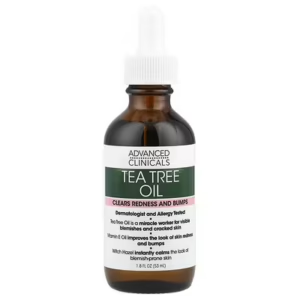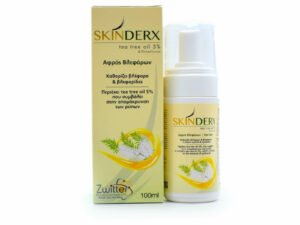A Century of Natural Healing: Tea Tree Oil’s Journey to Modern Eye Care
For nearly a century, tea tree oil has been recognized for its powerful therapeutic properties. Derived from the leaves of the Australian plant Melaleuca alternifolia, this essential oil has found its way into numerous health and wellness applications, including eye care. Today, tea tree oil is at the forefront of treating conditions like Demodex blepharitis—an increasingly recognized cause of chronic eye irritation and discomfort.
What Makes Tea Tree Oil Special?
Tea tree oil (TTO) is a complex mixture of over 100 components, but its therapeutic effects are primarily attributed to terpinen-4-ol (T4O), the most abundant and active ingredient. This naturally occurring compound gives tea tree oil its remarkable properties:
- Antimicrobial Activity: Effective against bacteria, viruses, and fungi
- Anti-inflammatory Effects: Helps reduce redness and swelling
- Antiparasitic Properties: Particularly effective against Demodex mites
The oil’s natural composition makes it a compelling alternative to conventional treatments, especially for those seeking natural remedies for chronic eye conditions.
Tea Tree Oil’s Role in Fighting Demodex Mites
Demodex mites are microscopic organisms that naturally inhabit human skin, including the face and eyelids. While typically harmless in small numbers, these mites can overpopulate and cause significant eye problems, particularly in older adults or those with compromised immune systems.
Research has shown that tea tree oil is exceptionally effective against Demodex mites for several reasons:
- Mite Repellent: Tea tree oil forces Demodex mites to emerge from hiding in hair follicles and oil glands
- Lethal Action: The terpinen-4-ol component disrupts the mites’ cell membranes, effectively killing them
- Continued Protection: Regular use helps prevent reinfestation
Scientific Evidence Supporting Tea Tree Oil for Eye Care
Over the past few decades, numerous scientific studies have examined tea tree oil’s effectiveness for eye conditions:
In Vitro Studies
Laboratory research has consistently demonstrated tea tree oil’s ability to kill Demodex mites outside the human body. Studies show that exposure to terpinen-4-ol, the active component in tea tree oil, can eliminate Demodex mites within 44-88 minutes, depending on concentration.
Clinical Research
Multiple clinical studies have investigated tea tree oil’s effectiveness in treating Demodex blepharitis:
- Research published in the Journal of Korean Medical Science found that tea tree oil eyelid scrubs significantly reduced Demodex counts and improved subjective symptoms in patients with ocular discomfort
- A comprehensive review conducted in 2022 analyzed multiple studies and confirmed tea tree oil’s efficacy for treating Demodex-related blepharitis
- Studies have shown that tea tree oil not only reduces mite populations but also alleviates inflammation and helps restore normal eyelid function
Application Methods in Modern Eye Care
Tea tree oil is never applied directly to the eyes in its pure form. Instead, it is used in various diluted formulations specially designed for eye care:
- Eyelid Wipes: Pre-moistened cloths containing diluted tea tree oil (typically 2-5%)
- Eyelid Foams and Cleansers: Gentle formulations for daily cleansing
- Eyelid Massage Oils: Diluted solutions (usually 5-10%) applied with a cotton swab to the base of eyelashes
- Specialized Shampoos: For cleansing the eyebrows and eyelids
Most eye care professionals recommend a concentration between 2-5% for regular use, as higher concentrations may cause irritation to sensitive eyelid tissue.
Balancing Benefits and Potential Concerns
While tea tree oil has shown significant promise in eye care, recent research has raised some important considerations:
- Potential Irritation: Some patients may experience temporary stinging or burning sensations
- Skin Sensitivity: A small percentage of people may have allergic reactions to tea tree oil
- Impact on Meibomian Glands: Recent studies suggest that high concentrations might affect the health of oil-producing glands in the eyelids
These findings underscore the importance of proper dilution and application methods, as well as professional guidance when using tea tree oil for eye conditions.
The Future of Tea Tree Oil in Eye Care
As research continues, tea tree oil is likely to remain a valuable tool in the eye care professional’s arsenal. Newer formulations are being developed with enhanced effectiveness and reduced potential for irritation.
Some emerging directions include:
- Optimized Concentrations: Finding the perfect balance between efficacy and safety
- Combination Therapies: Pairing tea tree oil with other treatments for enhanced results
- Advanced Delivery Systems: New methods to maximize benefits while minimizing side effects
When to Consider Tea Tree Oil for Your Eye Health
Tea tree oil-based products may be helpful if you experience:
- Chronic eyelid irritation, redness, or inflammation
- Persistent symptoms of dry eye that don’t respond to conventional treatments
- Cylindrical dandruff (collarettes) at the base of eyelashes
- Recurrent styes or chalazia (eyelid cysts)
- Symptoms that worsen with age
However, self-diagnosis and treatment are not recommended. Always consult with an eye care professional before beginning any treatment regimen, including those containing tea tree oil.
Conclusion: A Natural Solution with Scientific Backing
Tea tree oil represents a fascinating intersection of traditional natural medicine and modern scientific research. Its effectiveness against Demodex mites and associated eye conditions is supported by growing clinical evidence, making it a valuable option for many patients.
As with any treatment, tea tree oil works best as part of a comprehensive eye care approach that includes proper diagnosis, appropriate application methods, and regular professional monitoring. With the right approach, this natural remedy may offer relief to millions suffering from chronic eye irritation and discomfort.
This article is for informational purposes only and does not constitute medical advice. Always consult with a qualified eye care professional for diagnosis and treatment of medical conditions.





Leave a Reply